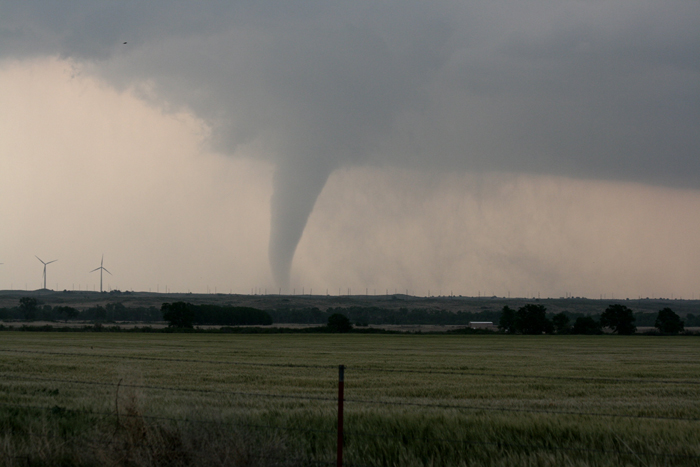2 April 2012
Tornado experts call for improved forecasting of deadly twisters
Posted by kramsayer

Tornadoes such as this one that recently touched down in Kansas can cause devastating localized damage. Scientists and severe weather experts at a March 29 Capitol Hill briefing stressed the need for better preparation when dealing with destructive twisters. (Credit: NOAA)
More than 250 tornadoes struck the United States in the first three months of 2012, touching down along a corridor from the Great Lakes to the Gulf Coast. Residents need to be better prepared for these deadly twisters, say scientists and experts on severe weather and emergency preparedness.
Ideally, tornadoes would be forecasted well before they touch down – instead of only minutes before, several experts said during a briefing for members of Congress and congressional staffers held on March 29 in Washington, D.C.
Tornado forecasting has improved over the past two decades, said David Stensrud, chief of the Forecast Research and Development Division at NOAA’s National Severe Storms Laboratory. In 1986, the time between when forecasters issued a tornado warming and when the twister touched down was three minutes. In 2011, that lead time had increased fivefold to 15 minutes. But Stensrud would like to see the lead time increase even more.
“We still have fatalities – we still need to do better,” Stensrud said. “So the question becomes, how do we improve what we’re already doing?”
Improvement could come in the form of new radar systems, he said. Typically, weather forecasters use Doppler radar to gauge the severity of storms. While effective, Doppler radar is slow and choppy, updating only every four to five minutes, Stensrud explained.
“If you think of a football game, the [Doppler] radar is like watching one play for every set [of plays] that happens,” he said. “You still see the game, you still see what happens, but you miss a lot of the continuity and a lot of the detail.”
Phased array radar, which uses multiple radar beams simultaneously as opposed to Doppler radar’s one beam, would update its data every minute, Stensrud said. That could increase tornado lead times even more. The new radar, combined with more advanced computer modeling of severe weather, could allow forecasters to predict tornadoes up to an hour in advance. Strensrud said this lead time is only about five to 10 years away.
But improved forecasting techniques and increased lead time are not the only important steps when it comes to saving lives. Getting the message to people in a tornado’s path and making sure they respond to it is equally critical, said Keith Stammer, director of the Emergency Management Division in Joplin County, Mo.
Many residents in tornado-prone areas are desensitized to tornado warnings by test sirens and false alarms, Stammer said.
“When someone hears the warning, they must hear it, understand it, believe it, personalize it, decide to act, and act appropriately,” he explained.
A lot of it comes down to psychology, said Julie Demuth, a scientist in the Societal Impacts Program at the National Center for Atmospheric Research in Boulder, Colo. People often seek confirmation of a threat before acting upon it, whether it is something as small as a smoke alarm going off or as large as a tornado.
So emergency managers should ensure there are multiple warning systems in place and make sure their meanings are clear, Demuth said. One way to help would be to issue different tiers of tornado warnings depending on the storm’s severity and potential damage, she said, something that the National Weather Service is currently considering. But even with these steps, there is always uncertainty inherent in severe weather situations, she said, whether it is uncertainty in how meteorologists forecast them or in how residents react to them.
Eric Villard, AGU science writing intern


 GeoSpace is a blog on Earth and space science, managed by AGU’s Public Information staff. The blog features posts by AGU writers and guest contributors on all sorts of relevant science topics, but with a focus on new research and geo and space sciences-related stories that are currently in the news.
GeoSpace is a blog on Earth and space science, managed by AGU’s Public Information staff. The blog features posts by AGU writers and guest contributors on all sorts of relevant science topics, but with a focus on new research and geo and space sciences-related stories that are currently in the news.
well , they might be better informed, but their houses should be built like iglooes.no corners!
The new doppler system has already provided extra warning time. I noticed that the NWS also changed their warnings to be more blunt. Timely article and well-done!